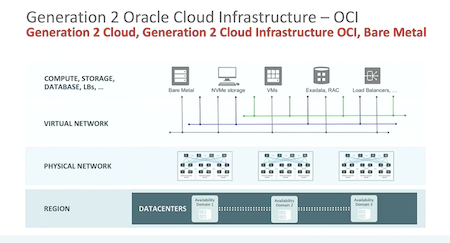

Larry Ellison doesn’t care much for Amazon Web Services (AWS) as a cloud competitor. In his keynote address at Oracle OpenWorld on Oct. 22, Ellison outlined the new Gen 2 Cloud platform, making constant competitive comparisons against AWS.
A primary message from Ellison is that the Gen 2 Oracle cloud is more secure, with autonomous capabilities to help protect against attacks. Ellison also emphasized the segmentation and isolation of workloads on the Gen 2 Oracle cloud, providing improved security.
The ability to easily move applications from the gen1 Oracle cloud to Gen 2 and from other clouds to Oracle is a cornerstone of the Gen 2 Oracle cloud, Ellison said.
“Our goal has always been as we move from one generation of computing to the next, as we moved from mainframes, to mini computers, to client server PC networks, to internet architecture to the cloud, in every generation, we want to protect your investment in data and applications,” Ellison said.
At the core of the Gen 2 Oracle Cloud Infrastructure is an RDMA (Remote Direct Memory Access) based network.
“It’s the ability of computers that are networked together to move data from one computer directly into the other computer without taking an operating system hit,” Ellison said. “It just goes direct from one spot to another; it creates a very low latency network, and you can move data very, very fast.”
RDMA is also at the core of Oracle’s engineered systems, the Exa-class servers, which run Oracle Linux.
Ellison said the cloud control plane in the Gen 2 Oracle cloud is physically separate from the data plane on which customer data and applications run, protecting the cloud perimeter and every user from every other user.
The Oracle Cloud footprint is also set to expand, as Ellison noted that Oracle will be implementing additional cloud locations and he added that Oracle is willing to build a Gen 2 Cloud in a customer’s data center as well.

As part of the Gen 2 rollout, Ellison announced new bare-metal services that enable organizations to provision their own Exadata server systems.
“If you’re very security conscious and you don’t want any other users in your Exadata machine, you want dedicated infrastructure, and you want complete isolation from other customers. We will we will provide that to you in our public cloud,” Ellison said. “It really is a unique feature of the Oracle generation 2 cloud, so you completely control that machine.”
Sean Michael Kerner is a senior editor at ServerWatch and InternetNews.com. Follow him on Twitter @TechJournalist.
Property of TechnologyAdvice. © 2025 TechnologyAdvice. All Rights Reserved
Advertiser Disclosure: Some of the products that appear on this site are from companies from which TechnologyAdvice receives compensation. This compensation may impact how and where products appear on this site including, for example, the order in which they appear. TechnologyAdvice does not include all companies or all types of products available in the marketplace.